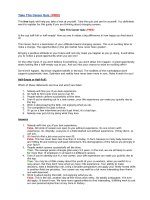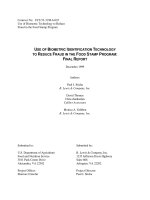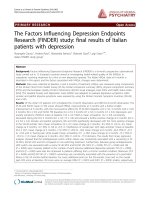Final Quiz.docx
Bạn đang xem bản rút gọn của tài liệu. Xem và tải ngay bản đầy đủ của tài liệu tại đây (29.18 KB, 4 trang )
Quiz in Acctg 113
a.
The materiality of the item in consideration
Instruction: Write the letter of your answer before
the number in a Capital letter.
b.
The pervasiveness of effect on financial
statements
1. A report with a disclaimer of opinion will have the
following change in the introductory paragraph
c.
Both the materiality and pervasiveness
should be considered
d.
The stage of completion of the engagement
at the time the management imposed the
scope limitation
a.
“We have audited….”
b.
“We cannot audit…”
c.
“We were engaged to audit…”
d.
“We have audited…”
6. An adverse opinion is issued when the auditor
believes
2. In a report with a disclaimer of opinion, this is not
found
a.
Statement that the auditor’s responsibility
is to express on the financial statement
b.
Reference to the Basis for Disclaimer of
Opinion paragraph
c.
General description of the audit
d.
Statement that the auditor was not able to
obtain sufficient appropriate audit evidence
3. Disclaimer of opinion is not the appropriate
opinion when
a.
Some parts of the financial statements are
materially misstated or misleading
b.
The financial statements will be found to be
misleading or misstated, if an adequate
investigation is performed
c.
The overall financial statements are so
materially misstated or misleading as a
whole that they do not present fairly the
financial position or results of operations
and cash flows in conformity with GAAP
d.
The audit firm is not independent
7. When the client fails to make adequate disclosure
in the body of the statements or in the related
footnotes, it is the responsibility of the auditor to
a.
There are multiple uncertainties
b.
Management fails
representations
written
a.
c.
Management refuses to include a required
information statements and underlying
records
Inform the reader that disclosure is not
adequate, and to issue a qualified or an
adverse opinion
b.
Inform the reader that disclosure is not
adequate, and to issue an unmodified or
qualified opinion
c.
Present the information in the audit report
and issue an unmodified or qualified
opinion
d.
Present the information in the audit report
and to a qualified or an adverse opinion
d.
to
furnish
The auditor is not independent
4. An auditor may not issue a qualified opinion when
a.
A scope limitation prevents the auditor
from completing an important audit
procedure
b.
The auditor’s report refers to the work of a
specialist
c.
The auditor lacks independence with
respect to the audited entity
d.
An accounting principle at variance with
generally accepted accounting principles is
used
5. In making a decision whether to disclaim an
opinion or withdraw from engagement due to a
management-imposed scope limitation, the auditor
should consider
8. The substantive reasons for providing an opinion
other than unmodified shall be presented
a.
Within
the
paragraph
auditor’s
responsibility
b.
Within the opinion paragraph
c.
After the auditor’s responsibility paragraph
but before the opinion paragraph
d.
After the opinion paragraph
9. It is appropriate to issue an adverse opinion when
the auditor
a.
b.
Has gathered sufficient appropriate
evidence that the financial statements are
not fairly stated
Management refuses to furnish written
representations
c.
Has knowledge that the Philippine
Standards on Auditing were not followed
d.
Was not able to gather sufficient
appropriate evidence regarding the fairness
of the financial statements
10. The signature in the audit report is the
a.
Personal name of the auditor
b.
Name of the audit firm
c.
Either A or B or both
d.
Either A or B but cannot be both
11. Auditor’s report on financial statements required
to be filed with the Philippine Securities and
Exchange Commission shall contain the following:
(choose the exception)
a.
Manual signature of the certifying partner
b.
Partner’s TIN and PRC registration numbers
c.
Accreditation with SEC
d.
Partner’s birth date and contact number
12.
An
auditor
discovered
a
P50,000
misappropriation by the payroll supervisor. The
company’s total assets and pre-tax income are P70
million and P15 million, respectively. Considering
materiality, the most likely opinion would be
14. “Independence” in auditing means
a.
Remaining aloof from client
b.
Not being financially dependent on client
c.
Being an advocate for the client
d.
Taking an unbiased viewpoint
15. In general, which of the following is not an
appropriate addressee of an independent auditor’s
report?
a.
Shareholders of the client company
b.
Company engaging the auditor
c.
Board of directors of the company
d.
President of the client company
16. The opinion paragraph of a standard unmodified
audit report does not
a.
State that the financial statements are
presented fairly in material respects
b.
Provide an unmodified opinion about the
fairness of the financial statements
c.
A conclusion whether the company
followed Philippine Financial Reporting
Standards
d.
State that the auditor has obtained
sufficient appropriate evidence to support
the opinion
17. Forever Inc., uses the weighted average method
to value half of its inventory and the first-in, first-out
method to value the other half. Assuming the
auditor is satisfied in all other respects, under the
circumstances the auditor will issue a(n)
a.
Unmodified
b.
Qualified
a.
Opinion modified due to inconsistency
c.
Adverse
b.
d.
Disclaimer
Unmodified opinion with an explanatory
paragraph
c.
Qualified or adverse opinion, depending on
materiality
d.
Unmodified opinion
13. If the balance sheet of a privately-held company
is dated December 31, 2005, the audit report is
dated March 6, 2006, and both are released on
March 15, 2006, this indicates that the auditor has
searched for material unrecorded transactions and
events that occurred up to
a.
December 31, 2005
b.
March 15, 2006
c.
December 31, 2006
d.
March 6, 2006
18. Which of the following statements regarding the
title of the audit report is incorrect?
a.
It emphasizes that the auditor
independent of the financial statements
is
b.
It distinguishes the report from those issued
by others
c.
It is the first element of the audit report
d.
It covers the reports presented as “other
information”
19. The terms “reasonable assurance” in the
auditor’s responsibility paragraph indicate that
23. Which of the following statements is an incorrect
use of the terminology?
a.
Evidence obtained from an independent
source outside the client organization is
more reliable than that obtained from
within.
b.
Documents that originate outside the
company are considered more reliable than
those that originate within the client’s
organization.
a.
No misstatements exist in the financial
statements
b.
No material misstatement exist in the
financial statements
c.
There is a possibility that material
misstatements still exist in the financial
statements
c.
There is a possibility that immaterial
misstatements still exist in the financial
statements
Documentary evidence is more reliable
when it is received by the auditor directly
from an independent third party.
d.
External evidence, such as communications
from banks, is generally regarded as more
reliable than answers obtained from
inquiries of the client.
d.
20. When the auditor provides an unmodified
opinion, it means that
a.
The financial statements are accurately
prepared
b.
The company is a viable option for
investment purposes
c.
There were no errors or fraudulent
activities found
d.
It is possible that material misstatements
are still present in the financial statements
21. Uniformity in reporting is indispensable because
it helps (choose exception)
24. Which of the following is not a specific audit
procedure enumerated in application and
explanatory material in PSA 500?
a.
Inspection
b.
Recalculation
c.
External confirmation
d.
Vouching
25. To gather evidence regarding the balance per
bank in a bank reconciliation, an auditor would
examine all of the following except
a.
Promote global credibility
a.
Cutoff bank statement
b.
Avoid confusion
b.
Year-end bank statement
c.
Users understand the report
c.
Bank confirmation
d.
Auditors avoid legal liability
d.
General ledger
22. Which of the following forms of evidence would
be least persuasive in forming the auditor’s opinion?
a.
b.
Responses to auditor’s questions by the
president and controller regarding the
investments account
Correspondence with a stockbroker
regarding the quantity of client’s
investment held in street name by the
broker
c.
Minutes of the board of directors
authorizing the purchase of stock as an
investment
d.
The auditor’s count of marketable securities
26. When the acceptable level of detection risk for
cash is high, the auditor may
a.
Review the client’s bank reconciliation
b.
Prepare the bank reconciliation using the
bank data in the client’s possession
c.
Obtain the bank statements directly from
the bank and prepare the bank
reconciliation
d.
Scan the client-prepared bank reconciliation
and verify the mathematical accuracy of the
reconciliation
27. Which of the following is a proper alternative
procedure when no response is obtained from a
positive confirmation request?
a.
Examination of subsequent cash receipts in
payment of the receivable
b.
Mailing negative confirmation request to
non-respondents
c.
Expansion of the sample by the number of
non-respondents
d.
Reduction of accounts receivable by the
amount of the no response
28. Which of the following procedures would least
likely lead the auditor to detect unrecorded fixed
assets disposals?
a.
Examine insurance policies
b.
Review property tax files
c.
Scan invoices for fixed asset additions
d.
Review repairs and maintenance expense
29. To gain assurance that all inventory items in a
client’s inventory listing schedule are valid, an
auditor most likely would trace
a.
Inventory tags noted during the auditor’s
observation to items listed in the inventory
listing schedule
b.
Inventory tags note during the auditor’s
observation to items listed in receiving
reports and vendor’s invoices
c.
Items listed in the inventory listing schedule
to inventory tags and the auditor’s recorded
count sheets
d.
Items listed in receiving reports and
vendor’s invoices to the inventory listing
schedule
30. Which of the following questions would an
auditor most likely include on an internal control
questionnaire for notes payable?
a.
Are assets that collateralize notes payable
critically needed for the entity’s continued
existence?
b.
Are two or more authorized signatures
required on checks that repay notes
payable?
c.
Are proceeds from notes payable used for
the purchase of noncurrent assets?
d. Are direct borrowings on notes payable
authorized by the board of directors?









